Explicit Modeling of Meteorological Explanatory Variables in Short-Term Forecasting of Maximum Ozone Concentrations via a Multiple Regression Time Series Framework
Abstract
:1. Introduction
2. Description of the Application Urban Location
2.1. Geographical and Meteorological Characteristics
2.2. Monitoring Network and Data
2.3. Ozone Pollution in the MMA
3. Methods
3.1. Data Processing
3.2. General Statistical Approach
- Calculation of residuals from a multiple regression model with transformed meteorological predictors.
- Identification of a SARMA model for the residuals via the ACF and PACF.
- Model fitting, in which meteorological effects and SARMA parameters are simultaneously estimated.
- Model diagnostic using Ljung-Box goodness of fit tests [51] and a comparison of empirical (P)ACF with the (P)ACF obtained by simulating from the fitted model.
- Model selection based on the previous two steps.
3.3. The SARMA Model
3.4. Meteorological Variables Transformations
3.5. Performance Measures
4. Statistical Analysis and Results
4.1. Model Estimation
4.2. Model Diagnostics
5. Forecast Performance
5.1. Results
5.2. Comparison with Other Studies
6. Conclusions
Supplementary Materials
Author Contributions
Funding
Acknowledgments
Conflicts of Interest
References
- Zhang, Y.; Bocquet, M.; Mallet, V.; Seigneur, C.; Baklanov, A. Real-time air quality forecasting, part I: History, techniques, and current status. Atmos. Environ. 2012, 60, 632–655. [Google Scholar] [CrossRef]
- Leelossy, Á.; Molnár, F.; Izsák, F.; Havasi, Á.; Lagzi, I.; Mészáros, R. Dispersion modeling of air pollutants in the atmosphere: A review. Cent. Eur. J. Geosci. 2014, 6, 257–278. [Google Scholar] [CrossRef]
- European Environment Agency. Outdoor Air Quality in Urban Areas. 2018. Available online: https://www.eea.europa.eu/airs/2017/environmentand-health/outdoor-air-quality-urban-areas (accessed on 10 November 2019).
- Dueñas, C.; Fernández, M.; Cañete, S.; Carretero, J.; Liger, E. Assessment of ozone variations and meteorological effects in an urban area in the Mediterranean coast. Sci. Total Environ. 2002, 299, 97–113. [Google Scholar] [CrossRef]
- Camalier, L.; Cox, W.; Dolwick, P. The effects of meteorology on ozone in urban areas and their use in assessing ozone trends. Atmos. Environ. 2007, 41, 7127–7137. [Google Scholar] [CrossRef]
- Wang, T.; Xue, L.; Brimblecombe, P.; Lam, Y.F.; Li, L.; Zhang, L. Ozone pollution in China: A review of concentrations, meteorological influences, chemical precursors, and effects. Sci. Total Environ. 2017, 575, 1582–1596. [Google Scholar] [CrossRef]
- Pusede, S.; Steiner, A.; Cohen, R. Temperature and recent trends in the chemistry of continental surface ozone. Chem. Rev. 2015, 115, 3898–3918. [Google Scholar] [CrossRef]
- Luna, A.; Paredes, M.; De Oliveira, G.; Corrêa, S. Prediction of ozone concentration in tropospheric levels using artificial neural networks and support vector machine at Rio de Janeiro, Brazil. Atmos. Environ. 2014, 98, 98–104. [Google Scholar] [CrossRef]
- Elangasinghe, M.A.; Singhal, N.; Dirks, K.N.; Salmond, J.A. Development of an ANN-based air pollution forecasting system with explicit knowledge through sensitivity analysis. Atmos. Pollut. Res. 2014, 5, 696–708. [Google Scholar] [CrossRef] [Green Version]
- Biancofiore, F.; Verdecchia, M.; Di Carlo, P.; Tomassetti, B.; Aruffo, E.; Busilacchio, M.; Bianco, S.; Di Tommaso, S.; Colangeli, C. Analysis of surface ozone using a recurrent neural network. Sci. Total Environ. 2015, 514, 379–387. [Google Scholar] [CrossRef]
- Feng, X.; Li, Q.; Zhu, Y.; Hou, J.; Jin, L.; Wang, J. Artificial neural networks forecasting of PM2.5 pollution using air mass trajectory based geographic model and wavelet transformation. Atmos. Environ. 2015, 107, 118–128. [Google Scholar] [CrossRef]
- Russo, A.; Lind, P.G.; Raischel, F.; Trigo, R.; Mendes, M. Neural network forecast of daily pollution concentration using optimal meteorological data at synoptic and local scales. Atmos. Pollut. Res. 2015, 6, 540–549. [Google Scholar] [CrossRef] [Green Version]
- Moustris, K.; Larissi, I.; Nastos, P.; Koukouletsos, K.; Paliatsos, A. Development and application of artificial neural network modeling in forecasting PM10 levels in a Mediterranean city. Water Air Soil Pollut. 2013, 224, 1634. [Google Scholar] [CrossRef]
- Cabaneros, S.M.; Calautit, J.K.; Hughes, B.R. A review of artificial neural network models for ambient air pollution prediction. Environ. Model. Softw. 2019, 119, 285–304. [Google Scholar] [CrossRef]
- Tikhe Shruti, S.; Khare, K.C.; Londhe, S.N. Forecasting Criteria Air Pollutants Using Data Driven Approaches; An Indian Case Study. IOSR J. Environ. Sci. Toxicol. Food Technol. 2013, 3, 1–8. [Google Scholar] [CrossRef]
- Dincer, N.G.; Akkus, Ö. A new fuzzy time series model based on robust clustering for forecasting of air pollution. Ecol. Inform. 2018, 43, 157–164. [Google Scholar] [CrossRef]
- Chaloulakou, A.; Saisana, M.; Spyrellis, N. Comparative assessment of neural networks and regression models for forecasting summertime ozone in Athens. Sci. Total Environ. 2003, 313, 1–13. [Google Scholar] [CrossRef]
- Domanska, D.; Wojtylak, M. Application of fuzzy time series models for forecasting pollution concentrations. Expert. Syst. Appl. 2012, 39, 7673–7679. [Google Scholar] [CrossRef]
- Blanchard, C.; Hidy, G.; Tanenbaum, S. Ozone in the southeastern United States: An observation-based model using measurements from the SEARCH network. Atmos. Environ. 2014, 88, 192–200. [Google Scholar] [CrossRef]
- Box, G.E.; Jenkins, G.M.; Reinsel, G.C.; Ljung, G.M. Time Series Analysis: Forecasting and Control, 5th ed.; John Wiley & Sons: Hoboken, NJ, USA, 2015. [Google Scholar]
- Kumar, K.; Yadav, A.; Singh, M.; Hassan, H.; Jain, V. Forecasting daily maximum surface ozone concentrations in Brunei Darussalam: An ARIMA modeling approach. J. Air Waste Manag. Assoc. 2004, 54, 809–814. [Google Scholar] [CrossRef] [Green Version]
- Duenas, C.; Fernández, M.; Canete, S.; Carretero, J.; Liger, E. Stochastic model to forecast ground-level ozone concentration at urban and rural areas. Chemosphere 2005, 61, 1379–1389. [Google Scholar] [CrossRef]
- Kumar, U.; Jain, V.K. ARIMA forecasting of ambient air pollutants (O3, NO, NO2 and CO). Stoch. Environ. Res. Risk Assess. 2010, 24, 751–760. [Google Scholar] [CrossRef]
- Ismail, M. Time-series analysis of ground-level ozone in Muda irrigation scheme area (Mada), Kedah. J. Sustain. Sci. Manag. 2011, 6, 79–88. [Google Scholar]
- Ivanov, A.; Voynikova, D.; Gocheva-Ilieva, S.; Boyadzhiev, D. Parametric time-series analysis of daily air pollutants of city of Shumen, Bulgaria. AIP Conf. Proc. 2012, 1487, 386–396. [Google Scholar]
- Beldjillali, H.; Lamri, N.; El Islam Bachari, N. Prediction of ozone concentrations according the Box-Jenkins methodology for Assekrem Area. Appl. Ecol. Environ. Sci. 2016, 4, 48–52. [Google Scholar] [CrossRef]
- Mahiyuddin, W.R.W.; Jamil, N.I.; Seman, Z.; Ahmad, N.I.; Abdullah, N.A.; Latif, M.T.; Sahani, M. Forecasting Ozone Concentrations Using Box-Jenkins ARIMA Modeling in Malaysia. Am. J. Environ. Sci. 2018, 14, 118–128. [Google Scholar] [CrossRef]
- Wu, E.M.Y.; Kuo, S.L. Air Quality Time Series Based GARCH Model Analyses of Air Quality Information for a Total Quantity Control District. Aerosol Air Qual. Res. 2012, 12, 331–343. [Google Scholar] [CrossRef] [Green Version]
- Kumar, U.; De Ridder, K. GARCH modelling in association with FFT-ARIMA to forecast ozone episodes. Atmos. Environ. 2010, 44, 4252–4265. [Google Scholar] [CrossRef]
- Kovac-Andric, E.; Brana, J.; Gvozdic, V. Impact of meteorological factors on ozone concentrations modelled by time series analysis and multivariate statistical methods. Ecol. Inform. 2009, 4, 117–122. [Google Scholar] [CrossRef]
- Ooka, R.; Khiem, M.; Hayami, H.; Yoshikado, H.; Huang, H.; Kawamoto, Y. Influence of meteorological conditions on summer ozone levels in the central Kanto area of Japan. Procedia Environ. Sci. 2011, 4, 138–150. [Google Scholar] [CrossRef] [Green Version]
- De Souza, A.; Aristones, F.; Pavão, H.G.; Fernandes, W.A. Development of a short-term ozone prediction tool in Campo Grande-MS-Brazil area based on meteorological variables. Open J. Air Pollut. 2014, 3, 42–51. [Google Scholar] [CrossRef] [Green Version]
- Grace, P.; Tsai, J.; Lai, H.; Tsai, D.; Li, L. Establishing multiple regression models for ozone sensitivity analysis to temperature variation in Taiwan. Atmos. Environ. 2013, 79, 225–235. [Google Scholar] [CrossRef]
- Wang, S. Time Series Analysis of Air Pollution in the City of Bakersfield, California. Ph.D. Thesis, University of California, Los Angeles, CA, USA, 2007. [Google Scholar]
- Sousa, S.; Martins, F.; Alvim-Ferraz, M.; Pereira, M.C. Multiple linear regression and artificial neural networks based on principal components to predict ozone concentrations. Environ. Model. Softw. 2007, 22, 97–103. [Google Scholar] [CrossRef]
- Díaz-Robles, L.A.; Ortega, J.C.; Fu, J.S.; Reed, G.D.; Chow, J.C.; Watson, J.G.; Moncada-Herrera, J.A. A hybrid ARIMA and artificial neural networks model to forecast particulate matter in urban areas: The case of Temuco, Chile. Atmos. Environ. 2008, 42, 8331–8340. [Google Scholar] [CrossRef] [Green Version]
- Yeganeh, B.; Motlagh, M.S.P.; Rashidi, Y.; Kamalan, H. Prediction of CO concentrations based on a hybrid partial least square and support vector machine model. Atmos. Environ. 2012, 55, 357–365. [Google Scholar] [CrossRef]
- Wang, P.; Liu, Y.; Qin, Z.; Zhang, G. A novel hybrid forecasting model for PM10 and SO2 daily concentrations. Sci. Total Environ. 2015, 505, 1202–1212. [Google Scholar] [CrossRef] [PubMed]
- Zhu, S.; Lian, X.; Liu, H.; Hu, J.; Wang, Y.; Che, J. Daily air quality index forecasting with hybrid models: Case in China. Environ. Pollut. 2017, 231, 1232–1244. [Google Scholar] [CrossRef] [PubMed]
- Medina Macaira, P.; Tavares Thomé, A.M.; Cyrino Oliveira, F.L.; Carvalho Ferrer, A.L. Time series analysis with explanatory variables: A systematic literature review. Environ. Model. Softw. 2018, 107, 199–209. [Google Scholar] [CrossRef]
- Instituto Nacional de Estadística, Geográfía e Informática. Las Zonas Metropolitanas en México. Censos Económicos. 2014. Available online: https://www.inegi.org.mx/contenidos/programas/ce/2014/doc/minimonografias/m_zmm_ce2014.pdf (accessed on 14 February 2019).
- Secretaría de Desarrollo Sustentable del Estado de Nuevo León. Estrategia de Desarrollo Urbano del Estado. 2017. Available online: http://www.nl.gob.mx/sites/default/files/presentacion_instalacion_cotdunl-final-.pdf (accessed on 10 November 2019).
- Instituto Nacional de Estadística, Geográfía e Informática. Producto Interno Bruto por Entidad Federativa 2017. Available online: https://www.inegi.org.mx/contenidos/saladeprensa/boletines/2018/OtrTemEcon/PIBEntFed2017.pdf (accessed on 10 November 2019).
- Secretaría de Desarrollo Sustentable del Estado de Nuevo León. Programa de Gestión para Mejorar la Calidad del Aire del Estado de Nuevo León ProAire 2016–2025. 2016. Available online: https://www.gob.mx/cms/uploads/attachment/file/250974/ProAire_Nuevo_Leon.pdf (accessed on 14 February 2019).
- Hernández-Paniagua, I.Y.; Clemitshaw, K.C.; Mendoza, A. Observed trends in ground-level O3 in Monterrey, Mexico, during 1993–2014: Comparison with Mexico City and Guadalajara. Atmos. Chem. Phys. 2017, 17, 9163–9185. [Google Scholar] [CrossRef] [Green Version]
- Instituto Nacional de Ecología; Secretaría de Medio Ambiente y Recursos Naturales. Cuarto Almanaque de Datos y Tendencias de la Calidad del Aire en 20 Ciudades Mexicanas (2000–2009). 2011. Available online: http://cambioclimatico.gob.mx:8080/xmlui/handle/publicaciones/340 (accessed on 12 June 2020).
- Carrillo-Torres, E.; Hernández-Paniagua, I.; Mendoza, A. Use of combined observational- and model-derived photochemical indicators to assess the O3-NOx-VOC system sensitivity in urban areas. Atmosphere 2017, 8, 22. [Google Scholar] [CrossRef] [Green Version]
- Harvey, A.C. Forecasting, Structural Time Series Models and the Kalman Filter; Cambridge University Press: Cambridge, UK, 1990. [Google Scholar] [CrossRef]
- Durbin, J.; Koopman, S.J. Time Series Analysis by State Space Methods, 2nd ed.; Oxford Statistical Science Series; Oxford University Press: Oxford, UK, 2012. [Google Scholar]
- R Core Team. R: A Language and Environment for Statistical Computing; R Foundation for Statistical Computing: Vienna, Austria, 2015; Available online: https://www.R-project.org (accessed on 10 November 2019).
- Ljung, G.M.; Box, G.E.P. On a measure of lack of fit in time series models. Biometrika 1978, 65, 297–303. [Google Scholar] [CrossRef]
- Hamilton, J.D. Time Series Analysis; Princeton University Press: Princeton, NJ, USA, 1994. [Google Scholar]
- Gardner, G.; Harvey, A.C.; Phillips, G.D.A. Algorithm AS 154: An algorithm for exact maximum likelihood estimation of autoregressive-moving average models by means of Kalman Filtering. J. R. Stat. Soc. Ser. C Appl. Stat. 1980, 29, 311–322. [Google Scholar] [CrossRef]
- Chambers, J.; Hastie, T. Statistical Models in S; Chapman & Hall/CRC: Boca Raton, FL, USA, 1992. [Google Scholar]
- Gorai, A.K.; Tuluri, F.; Tchounwou, P.B.; Ambinakudige, S. Influence of local meteorology and NO2 conditions on ground-level ozone concentrations in the eastern part of Texas, USA. Air Qual. Atmos. Health 2015, 8, 81–96. [Google Scholar] [CrossRef] [PubMed] [Green Version]
- Atkinson, R. Gas-phase tropospheric chemistry of organic compounds: A review. Atmos. Environ. 1990, 24, 1–41. [Google Scholar] [CrossRef]
- Porter, W.C.; Heald, C.L.; Cooley, D.; Russell, B. Investigating the observed sensitivities of air-quality extremes to meteorological drivers via quantile regression. Atmos. Chem. Phys. 2015, 15, 10349–10366. [Google Scholar] [CrossRef] [Green Version]
- Jacob, D.J.; Winner, D.A. Effect of climate change on air quality. Atmos. Environ. 2009, 43, 51–63. [Google Scholar] [CrossRef] [Green Version]
- Kukkonen, J.; Olsson, T.; Schultz, D.M.; Baklanov, A.; Klein, T.; Miranda, A.I.; Monteiro, A.; Hirtl, M.; Tarvainen, V.; Boy, M.; et al. A review of operational, regional-scale, chemical weather forecasting models in Europe. Atmos. Chem. Phys. 2012, 12, 1–87. [Google Scholar] [CrossRef] [Green Version]
- Arasa, R.; Soler, M.; Ortega, S.; Olid, M.; Merino, M. A performance evaluation of MM5/MNEQA/CMAQ air quality modelling system to forecast ozone concentrations in Catalonia. Tethys 2010, 7, 11–23. [Google Scholar] [CrossRef]
- Chai, T.; Kim, H.C.; Lee, P.; Tong, D.; Pan, L.; Tang, Y.; Huang, J.; McQueen, J.; Tsidulko, M.; Stajner, I. Evaluation of the united states national air quality forecast capability experimental real-time predictions in 2010 using air quality system ozone and NO2 measurements. Geosci. Model. Dev. 2013, 6, 1831–1850. [Google Scholar] [CrossRef] [Green Version]
- Curier, R.; Timmermans, R.; Calabretta-Jongen, S.; Eskes, H.; Segers, A.; Swart, D.; Schaap, M. Improving ozone forecasts over Europe by synergistic use of the LOTOS-EUROS chemical transport model and in-situ measurements. Atmos. Environ. 2012, 60, 217–226. [Google Scholar] [CrossRef]
- Baldasano, J.; Pay, M.; Jorba, O.; Gasso, S.; Jimenez-Guerrero, P. An annual assessment of air quality with the CALIOPE modeling system over Spain. Sci. Total Environ. 2011, 409, 2163–2178. [Google Scholar] [CrossRef] [Green Version]
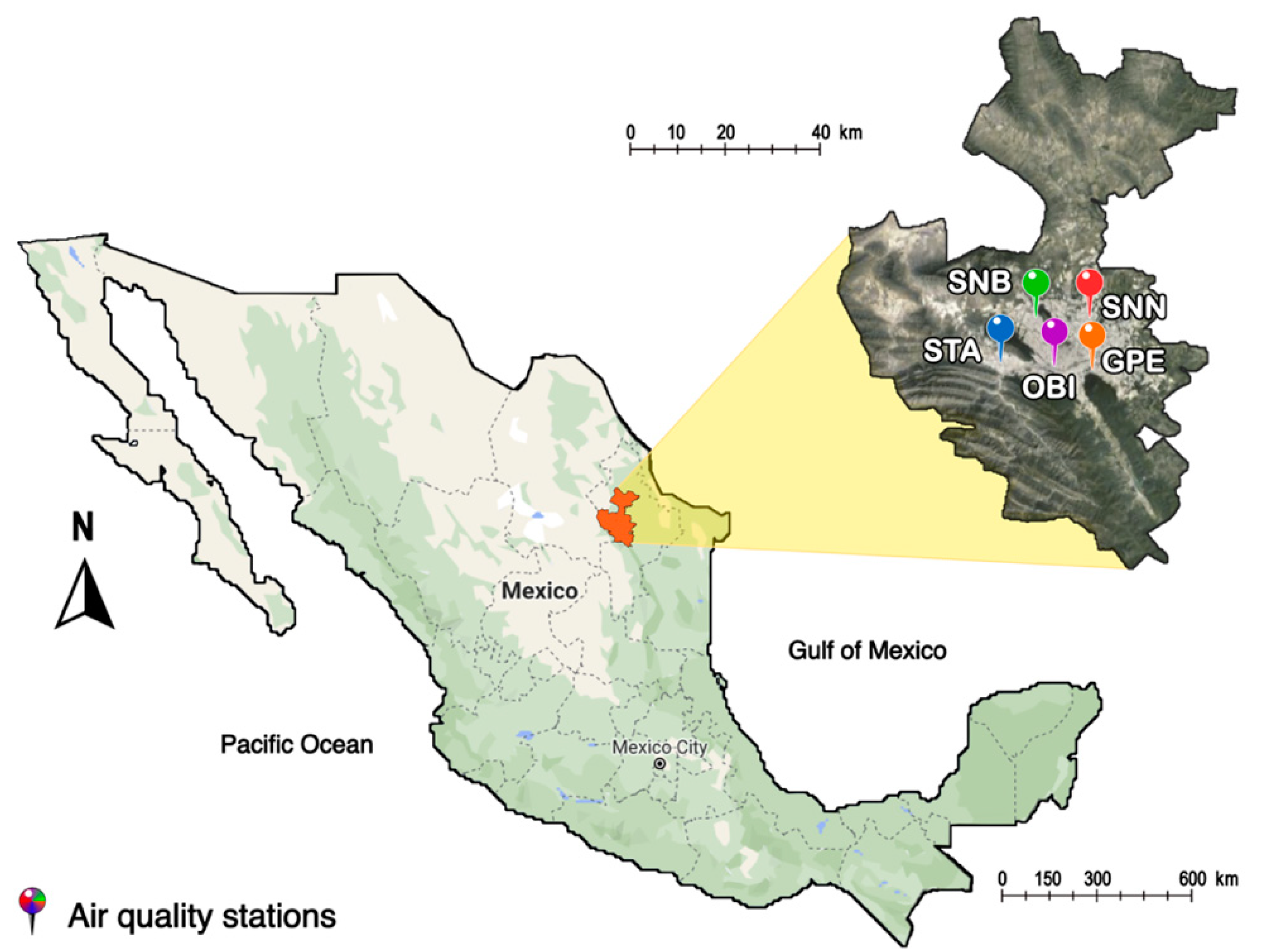
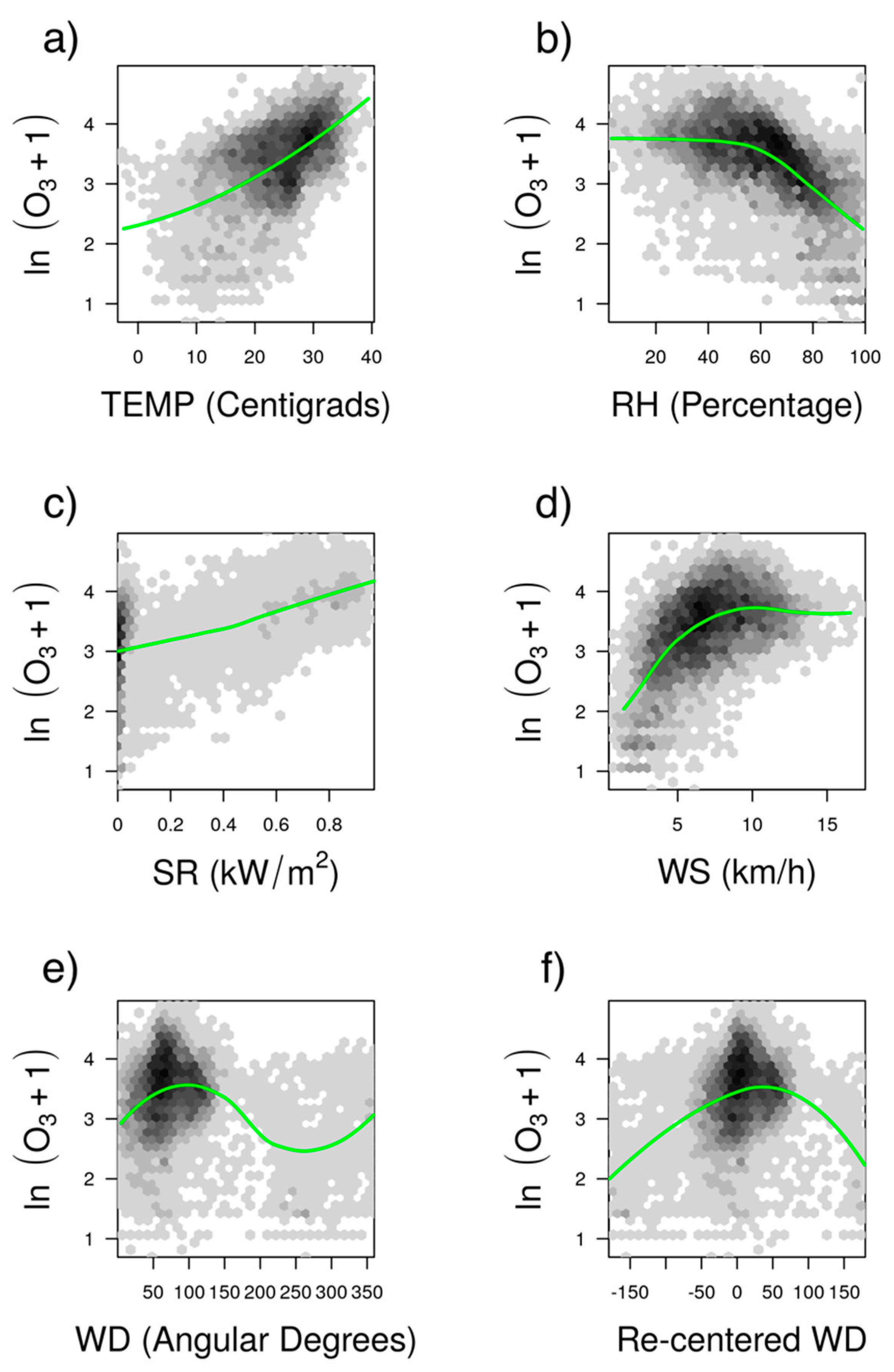
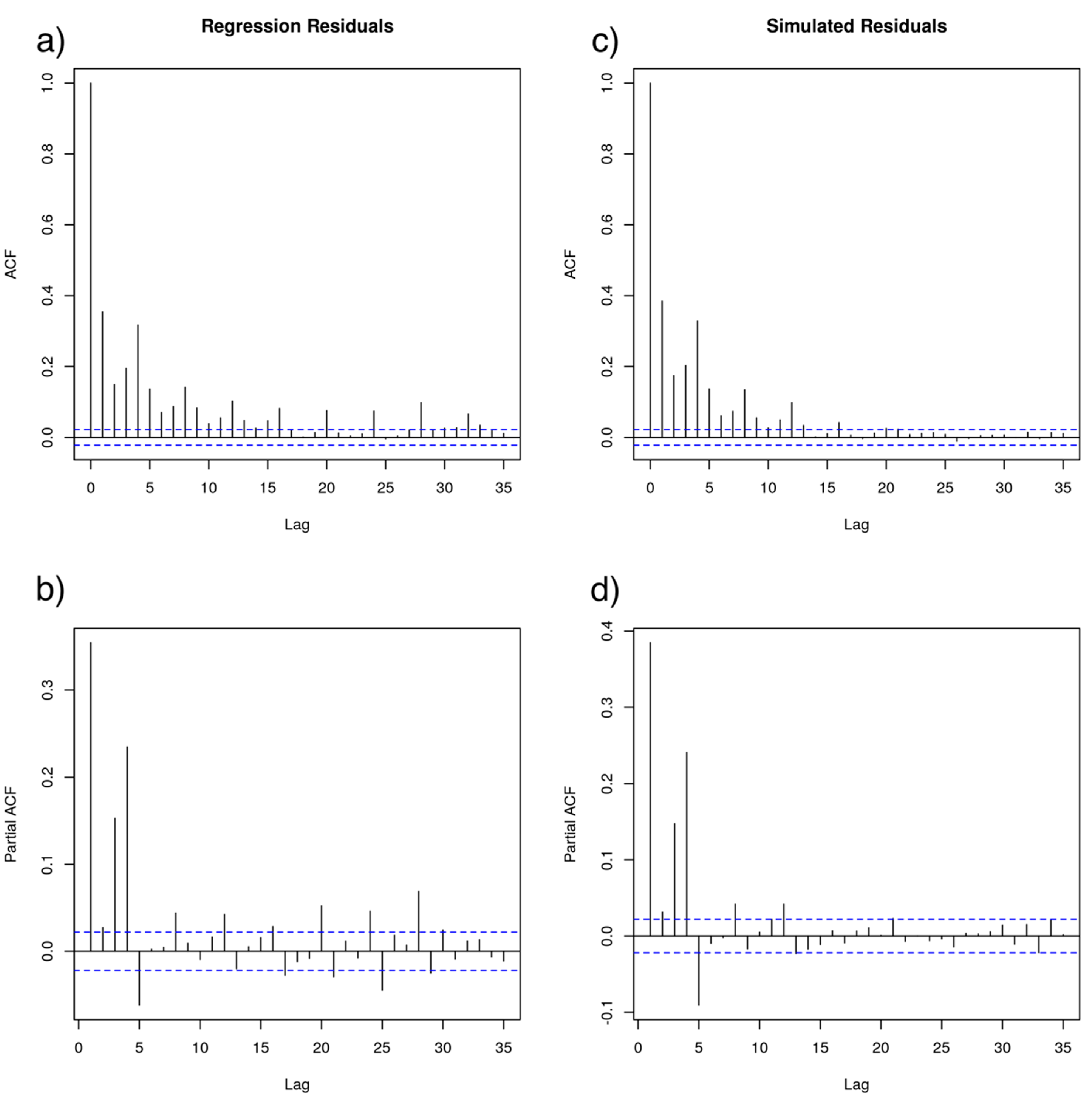
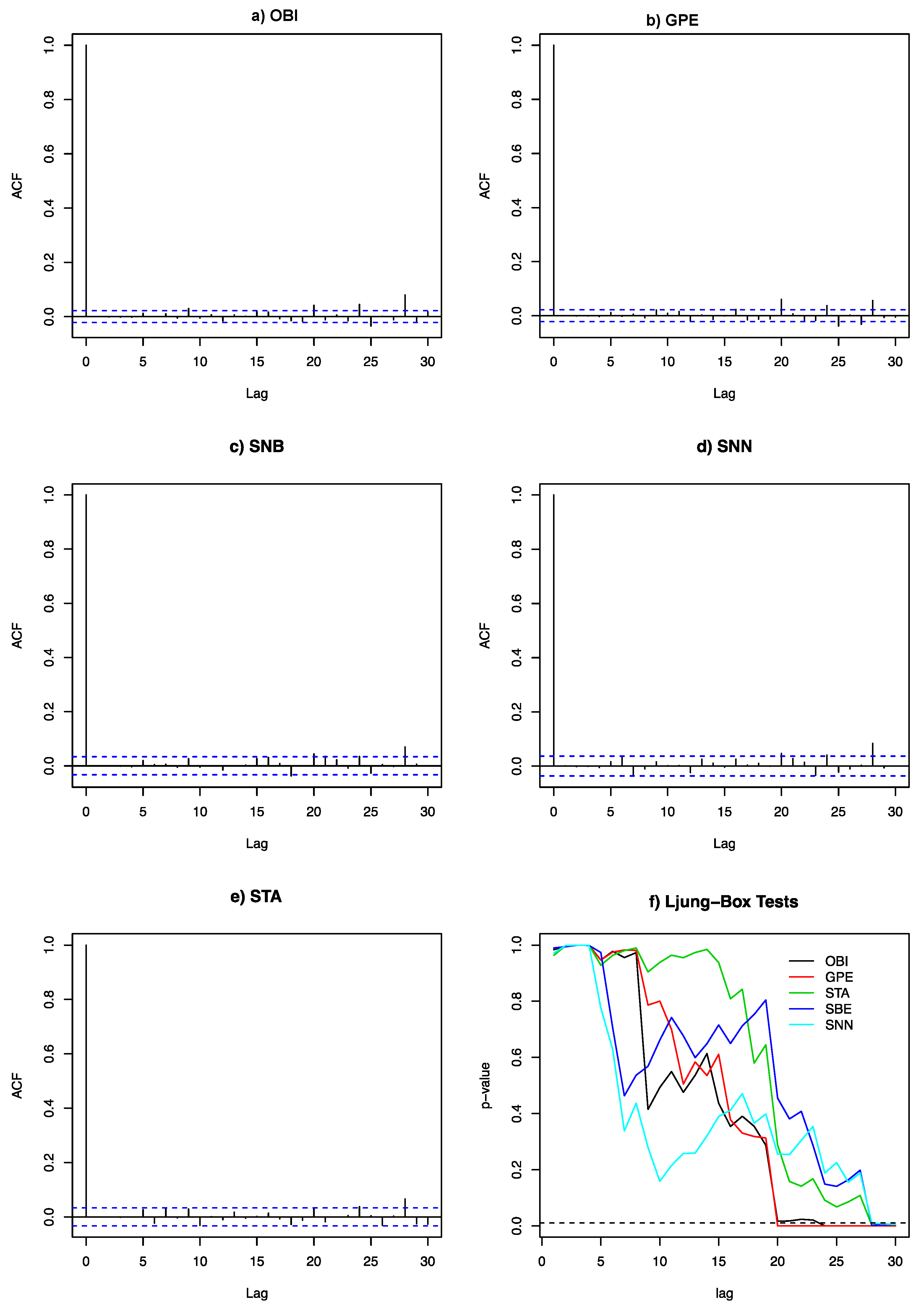
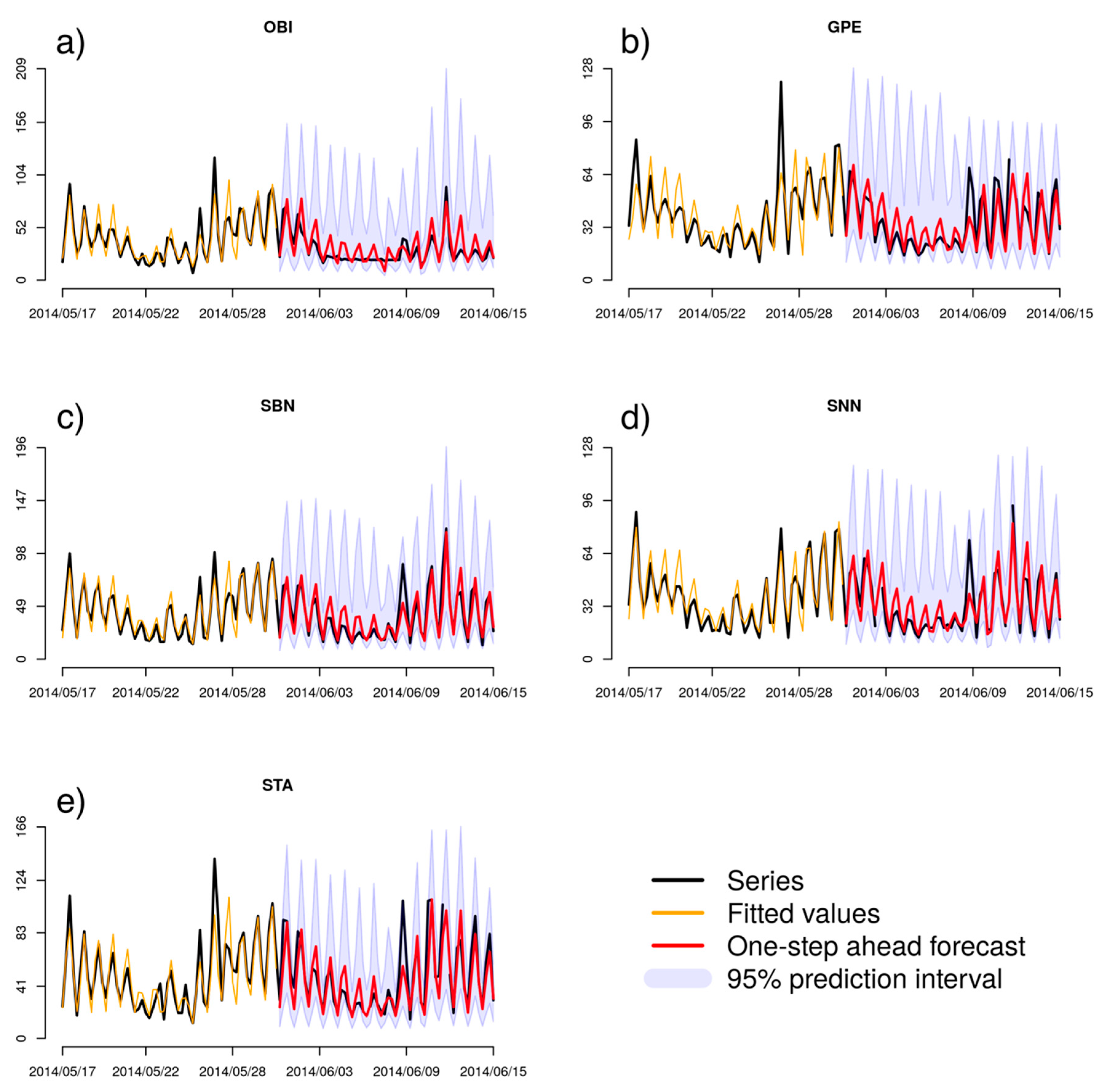
| Code | Location | Altitude (m a.s.l.) | Description | |
|---|---|---|---|---|
| N | W | |||
| OBI | 25 °40.561′ | 100° 20.314′ | 560 | Urban site near the city center of MMA |
| GPE | 25 °40.110′ | 100 °14.907′ | 492 | Urban background site in the La Pastora Park |
| SNB | 25 °45.415′ | 100 °21.949′ | 571 | Urban site downwind of industrial sources |
| SNN | 25 °44.727′ | 100 °15.301′ | 476 | Urban site surrounded by a large number of industries and residential areas |
| STA | 25 °40.542′ | 100 °27.901′ | 694 | Urban site in a residential area downwind of an industrial area, with high traffic volume |
| Time of Day | UTC | CST | DST |
|---|---|---|---|
| Overnight | 06:00–11:00 | 00:00–05:00 | 01:00–06:00 |
| Morning | 12:00–17:00 | 06:00–11:00 | 07:00–12:00 |
| Afternoon | 18:00–23:00 | 12:00–17:00 | 13:00–18:00 |
| Evening | 00:00–05:00 | 18:00–23:00 | 19:00–00:00 |
| Site | Time of Day (CST) | 1st h | 2nd h | 3rd h | 4th h | 5th h | 6th h |
|---|---|---|---|---|---|---|---|
| OBI | 00–05 | 0.49 | 0.14 | 0.12 | 0.09 | 0.08 | 0.07 |
| 06–11 | 0.07 | 0.00 | 0.00 | 0.00 | 0.05 | 0.88 | |
| 12–17 | 0.21 | 0.24 | 0.24 | 0.21 | 0.07 | 0.02 | |
| 18–23 | 0.64 | 0.05 | 0.05 | 0.08 | 0.07 | 0.12 | |
| GPE | 00–05 | 0.50 | 0.15 | 0.12 | 0.08 | 0.07 | 0.07 |
| 06–11 | 0.06 | 0.00 | 0.00 | 0.01 | 0.04 | 0.89 | |
| 12–17 | 0.23 | 0.22 | 0.22 | 0.18 | 0.11 | 0.04 | |
| 18–23 | 0.71 | 0.08 | 0.06 | 0.05 | 0.05 | 0.07 | |
| SNB | 00–05 | 0.50 | 0.16 | 0.11 | 0.10 | 0.07 | 0.06 |
| 06–11 | 0.04 | 0.01 | 0.00 | 0.01 | 0.04 | 0.90 | |
| 12–17 | 0.24 | 0.25 | 0.23 | 0.16 | 0.10 | 0.02 | |
| 18–23 | 0.76 | 0.05 | 0.03 | 0.04 | 0.04 | 0.07 | |
| SNN | 00–05 | 0.44 | 0.21 | 0.14 | 0.11 | 0.06 | 0.04 |
| 06–11 | 0.03 | 0.00 | 0.00 | 0.01 | 0.05 | 0.90 | |
| 12–17 | 0.25 | 0.22 | 0.24 | 0.18 | 0.08 | 0.02 | |
| 18–23 | 0.80 | 0.02 | 0.02 | 0.03 | 0.03 | 0.09 | |
| STA | 00–05 | 0.54 | 0.18 | 0.11 | 0.07 | 0.06 | 0.05 |
| 06–11 | 0.04 | 0.00 | 0.00 | 0.01 | 0.05 | 0.90 | |
| 12–17 | 0.18 | 0.24 | 0.28 | 0.20 | 0.09 | 0.02 | |
| 18–23 | 0.78 | 0.03 | 0.03 | 0.03 | 0.03 | 0.09 |
| Site | Dates | Total Number of Hourly Measurements | Number of Maximum O3 Concentrations |
|---|---|---|---|
| OBI | 2009-01-01/2014-05-31 | 47,448 | 7908 |
| GPE | 2009-01-01/2014-05-31 | 47,488 | 7908 |
| SNB | 2012-01-01/2014-05-31 | 21,168 | 3528 |
| SNN | 2012-06-01/2014-05-31 | 17,520 | 2920 |
| STA | 2012-01-01/2014-05-31 | 21,168 | 3528 |
| Site | Minimum | Maximum | Median | Mean | Std. Dev. |
|---|---|---|---|---|---|
| OBI | 1.00 | 143.00 | 31.00 | 34.22 | 22.10 |
| GPE | 3.00 | 163.00 | 34.00 | 37.30 | 21.04 |
| SNB | 1.00 | 135.00 | 35.00 | 38.12 | 22.35 |
| SNN | 2.00 | 128.00 | 31.00 | 33.41 | 18.78 |
| STA | 3.00 | 139.00 | 28.00 | 33.10 | 22.17 |
| TEMP | RH | SR | WS |
|---|---|---|---|
| ln(x + 273.15) | x + x2 + x3 | x + x2 | 1/(x + 1) |
| OBI | GPE | SNB | SNN | STA |
|---|---|---|---|---|
| −60 | −85 | −100 | −100 | −90 |
| Error Measure | Formula | Description |
|---|---|---|
| Root Mean Square Error (RMSE) | Standard deviation of the prediction error. | |
| Mean Absolute Error (MAE) | Average absolute error. | |
| Mean Absolute Percentage Error (MAPE) | Average of relative errors disregarding sign. | |
| Mean percentage error (MPE) | Average of relative errors indicating underestimation (+) or overestimation (−). | |
| Normalized Mean Error (NME) | Relative average absolute error. |
| Estimate | OBI | GPE | SNB | SNN | STA | |||||
|---|---|---|---|---|---|---|---|---|---|---|
| ф1 | 0.32021 | ** | 0.30840 | ** | 0.33812 | ** | 0.35416 | ** | 0.34970 | ** |
| ф2 | −0.00226 | −0.01218 | −0.01485 | −0.01835 | −0.03224 | |||||
| ф3 | 0.06896 | ** | 0.09320 | ** | 0.04394 | * | 0.09233 | ** | 0.04479 | * |
| Φ1 | 0.24433 | ** | 0.21859 | ** | 0.20467 | ** | 0.22561 | ** | 0.19251 | ** |
| Φ2 | 0.03525 | ** | 0.06964 | ** | 0.03416 | * | 0.06400 | ** | 0.06718 | ** |
| Φ3 | 0.05286 | ** | 0.05705 | ** | 0.06648 | ** | 0.09032 | ** | 0.02797 | |
| Intercept | −24.40754 | ** | −17.00805 | ** | −20.56420 | ** | −8.42725 | * | −36.24385 | ** |
| February | 0.06806 | 0.06748 | 0.05634 | 0.15388 | * | −0.00287 | ||||
| March | 0.18167 | ** | 0.18880 | ** | 0.14782 | ** | 0.22471 | ** | 0.08063 | |
| April | 0.28888 | ** | 0.20576 | ** | 0.22324 | ** | 0.23134 | ** | 0.13567 | * |
| May | 0.28450 | ** | 0.18094 | ** | 0.20718 | ** | 0.24077 | ** | 0.24019 | ** |
| June | 0.08708 | −0.02895 | −0.05266 | −0.02989 | −0.01343 | |||||
| July | 0.02414 | −0.08722 | −0.05908 | 0.01411 | −0.04515 | |||||
| August | −0.00757 | −0.07596 | −0.11810 | 0.03214 | −0.07216 | |||||
| September | 0.23205 | ** | 0.08155 | −0.07949 | 0.02770 | 0.05450 | ||||
| October | 0.24260 | ** | 0.16306 | ** | −0.02465 | −0.06163 | −0.02211 | |||
| November | 0.09435 | * | 0.06105 | 0.01926 | −0.02426 | 0.02542 | ||||
| December | −0.16914 | ** | −0.15147 | ** | −0.05993 | −0.21401 | ** | −0.13838 | * | |
| 06 to 11 h | −0.26308 | ** | 0.02381 | 0.15515 | ** | 0.02445 | −0.05687 | |||
| 12 to 17 h | −0.01417 | 0.16492 | ** | 0.26959 | ** | 0.15543 | ** | 0.13457 | ** | |
| 18 to 23 h | −0.04378 | * | 0.03123 | 0.01200 | −0.05736 | * | −0.06888 | ** | ||
| ln(TEMP + 273.15) | 4.88578 | ** | 3.62904 | ** | 4.23349 | ** | 2.08040 | ** | 6.98733 | ** |
| RH | 0.02732 | ** | 0.01414 | ** | 0.01507 | ** | 0.02013 | ** | 0.01868 | ** |
| RH2 | −0.00053 | ** | −0.00025 | ** | −0.00035 | ** | −0.00044 | ** | −0.00045 | ** |
| RH3 | 0.00000 | ** | 0.00000 | 0.00000 | * | 0.00000 | ** | 0.00000 | ** | |
| 1/(WS + 1) | −2.09803 | ** | −1.90418 | ** | −1.93226 | ** | −1.79201 | ** | −2.40912 | ** |
| SR | 1.02928 | ** | 0.36923 | ** | 0.81925 | ** | 1.03117 | ** | 0.78811 | ** |
| SR2 | −0.54808 | ** | −0.09435 | −0.40827 | * | −0.60301 | ** | −0.35532 | * | |
| WD | −0.00284 | ** | −0.00238 | ** | −0.00217 | ** | −0.00212 | ** | −0.00220 | ** |
| Performance Measure | OBI | GPE | SBN | SNN | STA |
|---|---|---|---|---|---|
| RMSE | 10.10 | 10.10 | 10.89 | 9.58 | 9.95 |
| MAE | 8.06 | 7.85 | 8.15 | 6.87 | 7.26 |
| MAPE | 32.31 | 27.65 | 29.96 | 25.65 | 28.87 |
| MPE | −9.29 | −10.64 | −8.53 | −6.13 | −7.28 |
| NME | 23.55 | 21.05 | 21.38 | 20.60 | 21.93 |
| Performance Measure | OBI | GPE | SBN | SNN | STA |
|---|---|---|---|---|---|
| RMSE | 9.72 | 10.73 | 12.50 | 9.46 | 14.62 |
| MAE | 6.77 | 8.07 | 9.03 | 6.75 | 9.74 |
| MAPE | 25.65 | 23.88 | 25.30 | 22.39 | 19.50 |
| MPE | −14.03 | −3.09 | −7.08 | −8.10 | 6.38 |
| NME | 25.70 | 24.10 | 23.00 | 21.37 | 21.17 |
Publisher’s Note: MDPI stays neutral with regard to jurisdictional claims in published maps and institutional affiliations. |
© 2020 by the authors. Licensee MDPI, Basel, Switzerland. This article is an open access article distributed under the terms and conditions of the Creative Commons Attribution (CC BY) license (http://creativecommons.org/licenses/by/4.0/).
Share and Cite
Iglesias-Gonzalez, S.; Huertas-Bolanos, M.E.; Hernandez-Paniagua, I.Y.; Mendoza, A. Explicit Modeling of Meteorological Explanatory Variables in Short-Term Forecasting of Maximum Ozone Concentrations via a Multiple Regression Time Series Framework. Atmosphere 2020, 11, 1304. https://doi.org/10.3390/atmos11121304
Iglesias-Gonzalez S, Huertas-Bolanos ME, Hernandez-Paniagua IY, Mendoza A. Explicit Modeling of Meteorological Explanatory Variables in Short-Term Forecasting of Maximum Ozone Concentrations via a Multiple Regression Time Series Framework. Atmosphere. 2020; 11(12):1304. https://doi.org/10.3390/atmos11121304
Chicago/Turabian StyleIglesias-Gonzalez, Sigfrido, Maria E. Huertas-Bolanos, Ivan Y. Hernandez-Paniagua, and Alberto Mendoza. 2020. "Explicit Modeling of Meteorological Explanatory Variables in Short-Term Forecasting of Maximum Ozone Concentrations via a Multiple Regression Time Series Framework" Atmosphere 11, no. 12: 1304. https://doi.org/10.3390/atmos11121304







